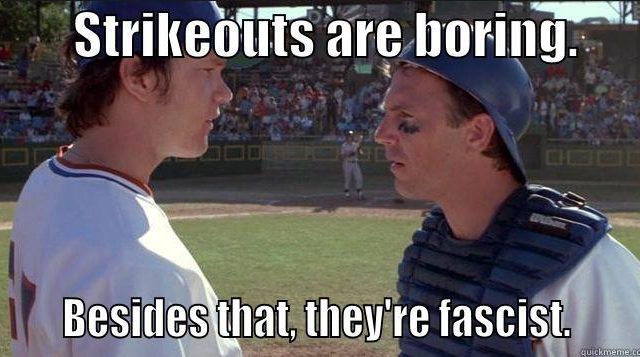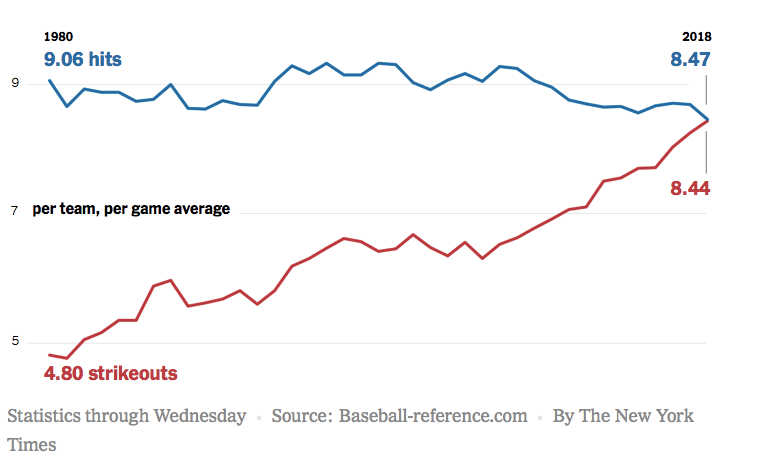Baseball and Housing: Hitting, Pitching, and Supply Have a Simple Fix
I’ve long compared the hunger to regulate the housing market down to the color of doorknobs on the bathroom doors of new apartments with people’s view of something seemingly completely unrelated: baseball. As is often the case, my intuition — and just ambient awareness — is right. People like to see the outcomes they want whether it is in the built environment, politics, and even sports. And that doesn’t even mean just one’s favorite team winning games it also comes down to nuances like the pace of the game. A little while back the New York Times ran an article, More Strikeouts Than Hits? Welcome to Baseball’s Latest Crisis; sound familiar. I’m not trivializing housing here nor people’s serious interest in the sport, just making a point about human nature, averages, and keeping everything in perspective.
Just like housing, where people obsess about average quarter over quarter changes in prices, sports fans obsess about averages too.
The “crisis” in baseball is that the game is slowing down. The game is becoming a game of chess between power hitters and power pitchers. Pitch after pitch is thrown. We look at our phones. Take selfies. Eat hot dogs. Oh, a hit! A home run? Now it’s 1 to 0. It starts to feel like <face palm> soccer. This is America after all. We want action. Baseball remains the iconic American sport,
And yet attendance is down, and more and more balls are being kept out of play. Some longtime observers consider the shifting landscape — hitters swinging for the fences, pitchers throwing everything with maximum effort, fielders standing in unusual spots — and wonder what has happened to their game.
This reminds me of the argument in housing that builders are only producing “luxury apartments.” My response is always, “there are no luxury apartments, only scarce ones.” Except in Manhattan, wealthy people rarely live in apartments. When prices go up, it isn’t because new apartments have gold fixtures, it is because demand is outpacing supply. People complain that the housing market is like shopping in a grocery store that sells only caviar or peanut butter. Why? Because it’s all about the profits.
The Times story shows that, as in housing, fans see a conspiracy of wheeling in dealing owners being more worried about winning games and the certainty of strikeouts and home runs as ruining the game. Somehow everything is rigged to benefit a certain outcome. And like people complaining about how Seattle is losing its “laid back charm” because of growth, baseball fans complain and “wonder what has happened to their game.” And like in housing they complain to the people in charge.
“You can’t change the way the competitive people that run clubs are thinking about the game because they think they’ve figured out the way to win more games,” [Baseball Commissioner Rob] Manfred said. “The only option available to us is to have dialogue with the people that play the game every day and figure out what rules, if any, ought to be put in place to kind of check, or manage, these organic developments that are ongoing.”
Sounds like a Seattle City Councilmember. Time to change the rules to deliver the outcome the people in the stands are demanding. Remember this is sports we’re talking about, not people’s economic well being.
What does all this say about human beings? Well, people want outcomes, in almost every arena, literal or figurative, to respond to their whims. If the game of baseball slows down because pitchers and hitters are better at their jobs — pitching and hitting — that’s, as the character in Bull Durham said, “fascism.” It isn’t. Changes in the statistical outcomes are real, but they are reflective of human beings in a system following the incentives in the system. Maybe it makes sense to change some things like the height of the pitchers mound, something that has been in contention for over a hundred years.
In 1893, to create more offense, the box was replaced with a raised mound and a rubber slab 12 inches long and relocated further back to 60 1/2 feet from home plate. Pitches were required to be touching with their back foot and the rubber plate was 60 1/2 feet away from home plate.
The extra five feet was significant, as it cut down on the angle of the pitches and the league batting average spiked up 35 pts. in 1893 and another 29 pts. in 1894.
Rules do matter and every game and market needs them not to control home runs and strikeouts but to create some predictability. People can’t play a game or live and work in a market unless there are some consistent rules. Data also matter. When strikeouts or housing prices go up it’s worth having the debate. But the housing debate is battling not over the height of the mound, but over every single pitch and every single hit. And the answer to rising prices is simple: more housing of all kinds in all parts of the city for people of all levels of income. It’s simple and not ideological or political at all; a lot like changing the pitchers mound.



